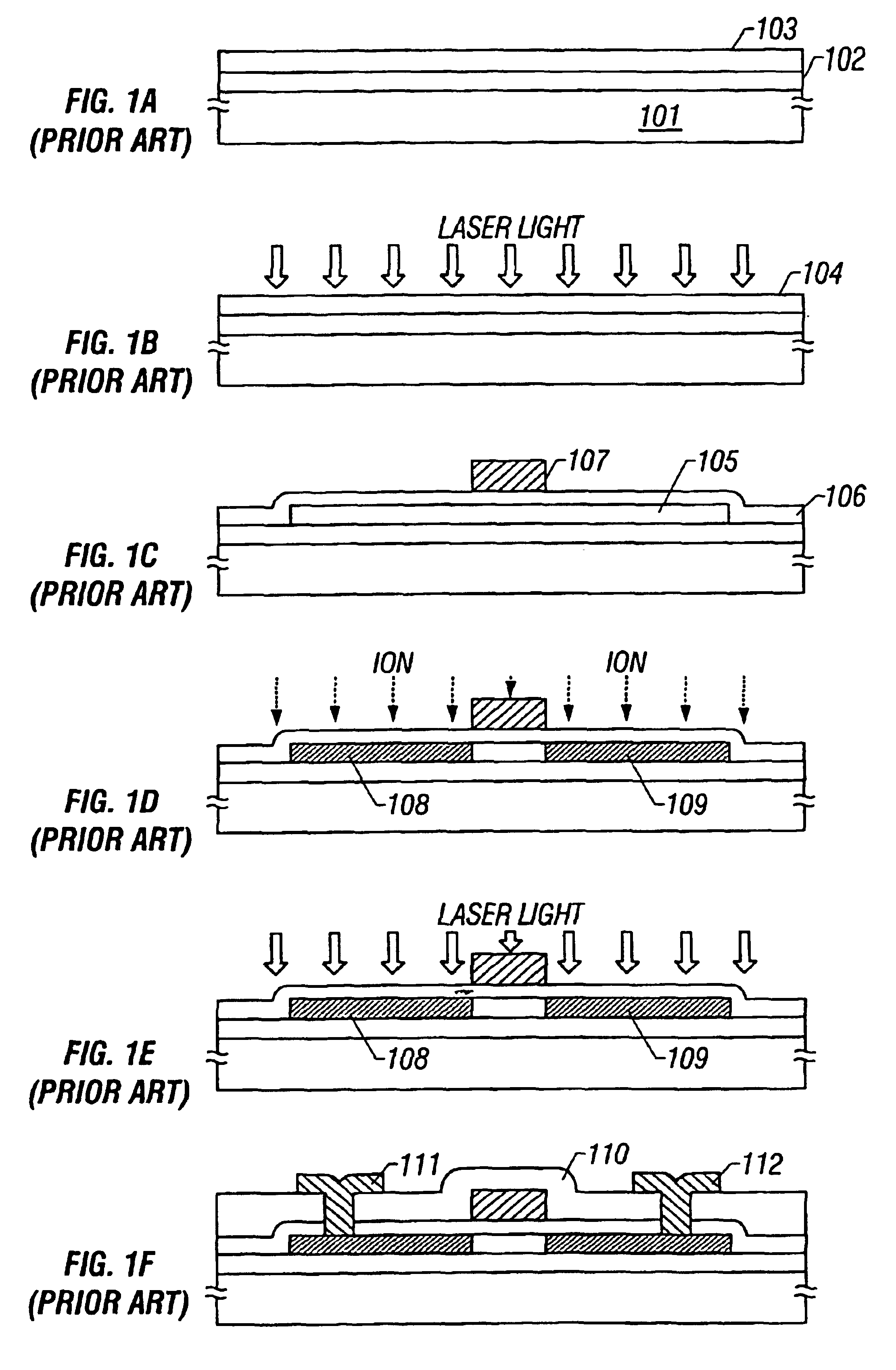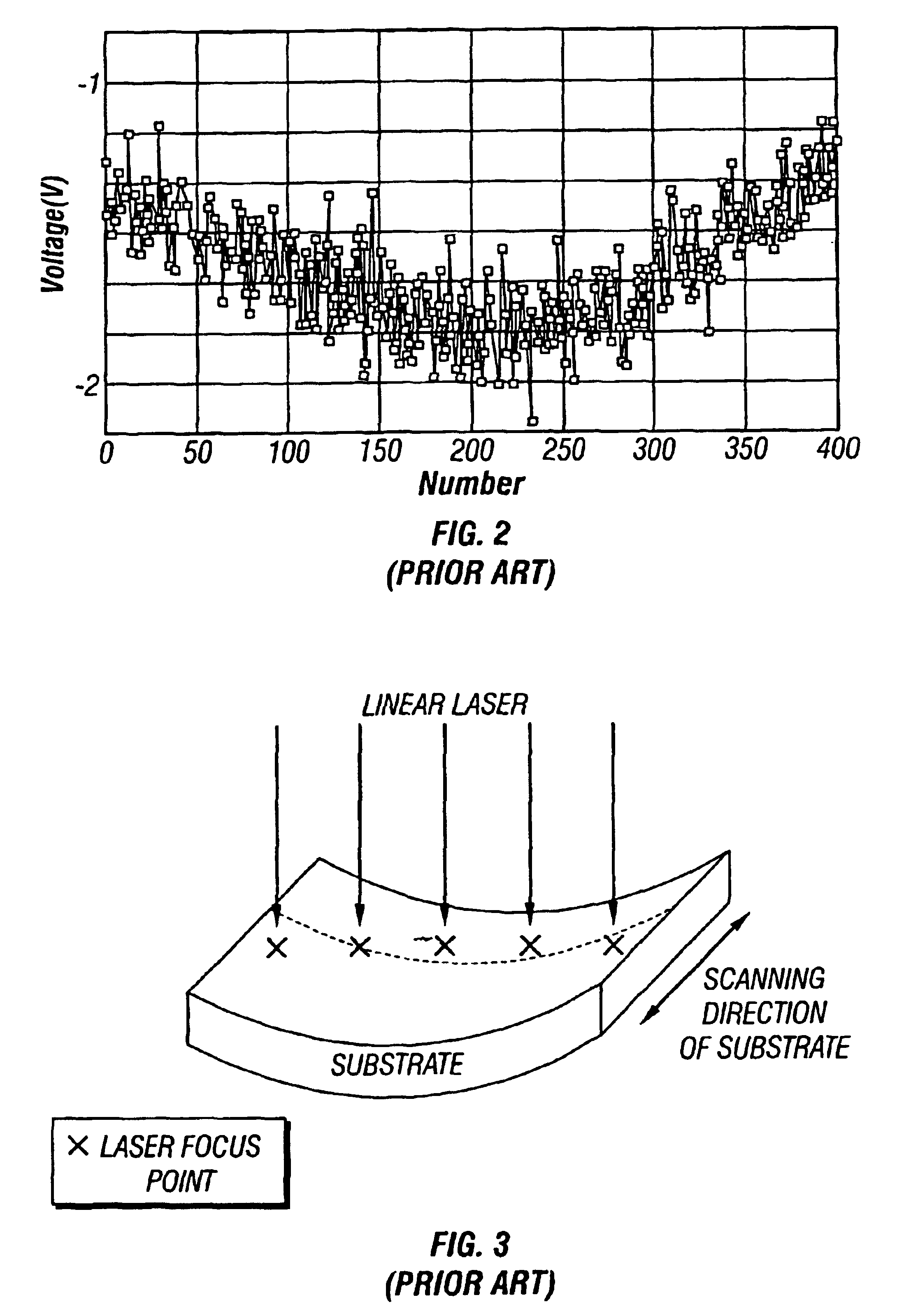Method and apparatus for producing semiconductor device
a semiconductor and device technology, applied in the field of semiconductor device production methods and apparatuses, can solve the problems of difficult to obtain pmos tft, amorphous silicon cannot be used to produce p-channel tft, and the tft is not available to the tfts
- Summary
- Abstract
- Description
- Claims
- Application Information
AI Technical Summary
Benefits of technology
Problems solved by technology
Method used
Image
Examples
first embodiment
[0126]FIGS. 1A to 1F show a process of producing a thin film transistor (TFT) in accordance with a first embodiment.
[0127]An under silicon oxide film 102 having a thickness of 2000 Å is formed on a glass substrate (in this embodiment, using a Corning 7059 of 100 mm square), and an amorphous silicon film 103 having a thickness of 500 Å is formed sequentially on the under silicon oxide film 102 by plasma CVD.
[0128]Then, in order to add nickel as a catalytic element that promotes crystallization, nickel acetate aqueous solution of 10 ppm is coated on the surface of silicon, and nickel acetate layer not shown is formed through the spin coating technique.
[0129]It is more preferable that a surface active agent is added to the nickel acetate aqueous solution. Since the nickel acetate layer is very thin, although it is not limited to a film shape, it does not suffer from a problem in the subsequent process (FIG. 1A).
[0130]Then, the glass substrate 101 is located on a stage having a surface ...
second embodiment
[0153]A second embodiment will be described with reference to FIGS. 1A to 1F. An under silicon oxide film 102 having a thickness of 2000 Å is formed on a glass substrate 101 (In this embodiment, there is used a Corning 1737 of 400×500 mm square and 0.7 mm thickness. Another glass substrate such as Corning 7059, OA2, NA45, etc., may be used.), and an amorphous silicon film 103 having a thickness of 500 Å is formed sequentially on the under silicon oxide film 102 by plasma CVD.
[0154]Then, nickel acetate aqueous solution of 10 ppm is coated on the surface of silicon, and a nickel acetate layer not shown is formed by spin coating.
[0155]It is more preferable that a surface active agent is added to the nickel acetate aqueous solution. Since the nickel acetate layer is very thin, although it is not necessarily to be in a film shape, it does not suffer from any problem in the subsequent process (FIG. 1A).
[0156]Then, the glass substrate 101 is thermally annealed at 550° C. for four hours, to...
third embodiment
[0197]Although in the second embodiment, the glass substrate 101 of 400×500 mm square is used, in a third embodiment, Corning 7059 of 100 mm square is used for a glass substrate. Hence, in flattening the glass substrate which has been subjected to the crystallizing process, the shape of a stage on which the glass substrate shown in FIG. 6A is mounted may be of the inverse U-shape type convex curved surface which is curved in one direction.
[0198]The glass substrate is put on the stage having the inverse U-shape type convex curved surface, and an appropriate heat is applied to the glass substrate. Then, the glass substrate is deformed along the stage by self-weight and heat. In this situation, when the glass substrate is cooled, the silicon film formed on the substrate contracts more sharply than the glass substrate, with the result that an extremely flat glass substrate can be obtained.
[0199]Thereafter, a TFT is fabricated in the same manner as that of the first embodiment.
[0200]The ...
PUM
| Property | Measurement | Unit |
|---|---|---|
| length | aaaaa | aaaaa |
| surface roughness | aaaaa | aaaaa |
| length | aaaaa | aaaaa |
Abstract
Description
Claims
Application Information
 Login to View More
Login to View More - R&D
- Intellectual Property
- Life Sciences
- Materials
- Tech Scout
- Unparalleled Data Quality
- Higher Quality Content
- 60% Fewer Hallucinations
Browse by: Latest US Patents, China's latest patents, Technical Efficacy Thesaurus, Application Domain, Technology Topic, Popular Technical Reports.
© 2025 PatSnap. All rights reserved.Legal|Privacy policy|Modern Slavery Act Transparency Statement|Sitemap|About US| Contact US: help@patsnap.com



